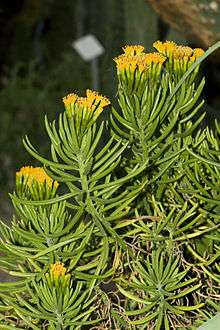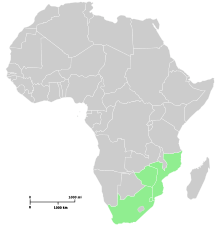Senecio barbertonicus
The Barberton groundsel[2] or succulent bush senecio[3] (Senecio barbertonicus Klatt) is an evergreen succulent shrub of the family Asteraceae and genus Senecio, native to Southern Africa,[1] named after one of its native localities Barberton and is now also being cultivated elsewhere for its drought resistance, clusters of sweetly scented,[3] golden-yellow, tufted flower heads in winter and attractiveness to butterflies,[2] the painted lady butterfly (Vanessa cardui) in particular.[4]
| Senecio barbertonicus | |
|---|---|
 | |
| Barberton groundsel | |
| Scientific classification | |
| Kingdom: | Plantae |
| Clade: | Tracheophytes |
| Clade: | Angiosperms |
| Clade: | Eudicots |
| Clade: | Asterids |
| Order: | Asterales |
| Family: | Asteraceae |
| Genus: | Senecio |
| Species: | S. barbertonicus |
| Binomial name | |
| Senecio barbertonicus | |
 | |
| Range of Senecio barbertonicus. | |
Description
A succulent bush growing over 6 feet (2 m) tall and wide with a fleshy trunk, light green, cylindrical, finger-like leaves 2 inches (5 cm) to 4 inches (10 cm) in length and 0.2 inches (0.51 cm) to 0.4 inches (1.0 cm) in diameter, densely packed around the stem and curved at the base to lie parallel to the stem and pointing upwards.[5]
The fragrant yellow flowers, 0.4 inches (1.0 cm) wide and 3 inches (7.6 cm) long, bloom July through September,[3] are terminal and produce seeds with a dense tuft of bristles.
Senecio barbertonicus is hardy to at least 25 °F (−4 °C).[4]
Distribution
Senecio barbertonicus grows predominantly in rocky grassland and bushveld in Southern Africa in areas ranging from Swaziland and Mozambique, to Eastern parts of Zimbabwe and South Africa[3] at altitudes between 110 feet (34 m) and 5,500 feet (1,700 m).[6]
It is locally common in protected areas in eastern, central, and southwestern Swaziland[7] in Gauteng, KwaZulu-Natal, Limpopo, Mpumalanga and North-West.[6]
References
- The Southern African Botanical Diversity Network (2006-01-20). "Final Swaziland Tree ATlas index" (PDF). Archived from the original (PDF) on 2008-11-21. Retrieved 2008-02-27.
- The Friends of U.C. Riverside Botanic Gardens (2007-10-20). "SHRUBS". Archived from the original on September 9, 2006. Retrieved 2008-02-27.
- Carruthers, Vincent (2005) [2005]. "Wild Flowers". The Wildlife of Southern Africa: A Field Guide to the Animals and Plants of the Region. Struik. pp. 310 pages. ISBN 1-86872-451-4. Retrieved 2008-02-27.
- "Senecio barbertonicus - Succulent Bush Senecio". San Marcos Growers Web Site. Retrieved 2008-02-27.
- "Senecio barbertonicus Klatt". Swaziland's Flora Database. South African National Botanical Institute (PRECIS database) and the Swaziland National Herbarium. Retrieved 2008-02-27.
- "Senecio barbertonicus Klatt". African Flowering Plants Database. Conservatoire et Jardin botaniques de la Ville de Genève and South African National Biodiversity Institute, Pretoria. Archived from the original on 2013-01-16. Retrieved 2008-02-27.
- The Southern African Botanical Diversity Network. "SABONET Tree Atlas Report No. 38" (PDF). Swaziland Tree Atlas. Archived from the original (PDF) on 2008-11-21. Retrieved 2008-02-27.
Further reading

- Wild Flowers of KwaZulu-Natal - Elsa Pooley (Natal Flora Trust, Durban 1998) ISBN 0-620-21500-3
- "The Succulent Senecios of South Africa". The Guide to Life, The Universe and Everything. 2003-07-13. Archived from the original on 2009-05-11. Retrieved 2008-02-27.